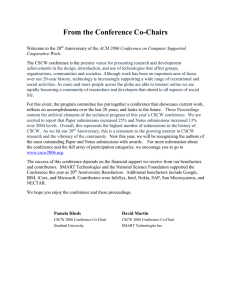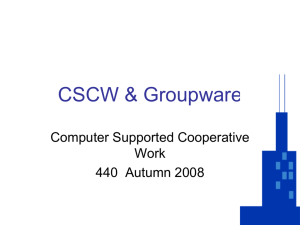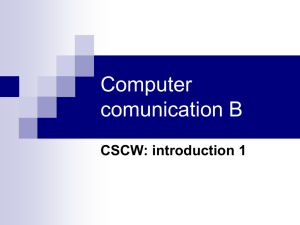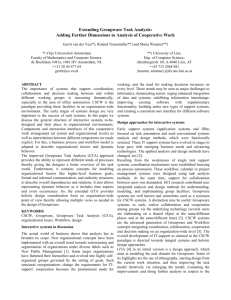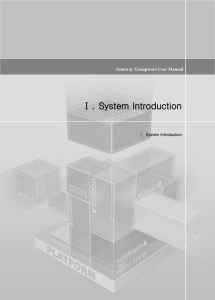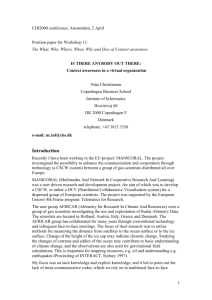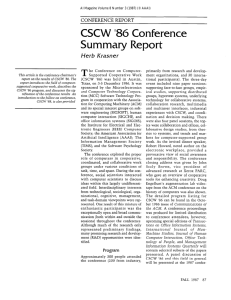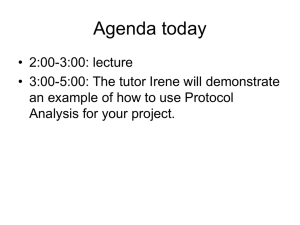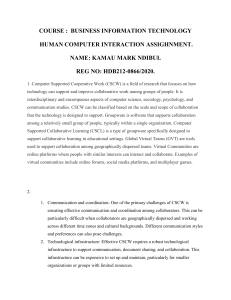Computer - Supported Cooperative Work (CSCW)
advertisement
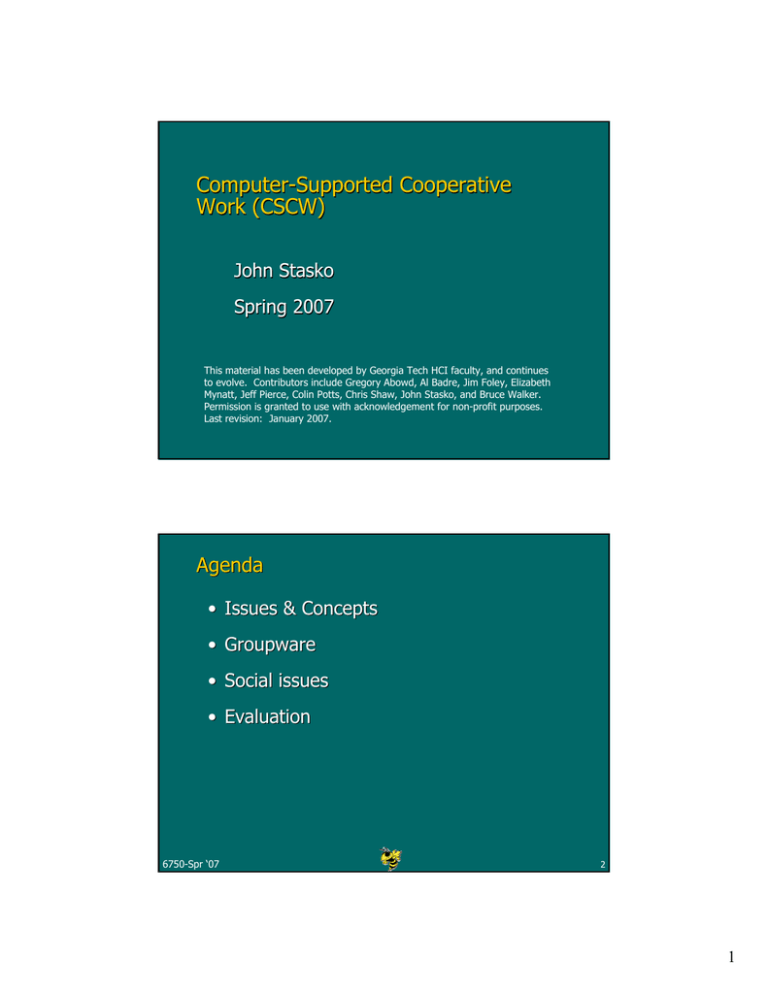
Computer-Supported Cooperative Work (CSCW) John Stasko Spring 2007 This material has been developed by Georgia Tech HCI faculty, and continues to evolve. Contributors include Gregory Abowd, Al Badre, Jim Foley, Elizabeth Mynatt, Jeff Pierce, Colin Potts, Chris Shaw, John Stasko, and Bruce Walker. Permission is granted to use with acknowledgement for non-profit purposes. Last revision: January 2007. Agenda • Issues & Concepts • Groupware • Social issues • Evaluation 6750-Spr ‘07 2 1 CSCW • Computer Supported Cooperative Work – Study of how people work together as a group and how technology affects this – Support the social processes of work, often among geographically separated people *Mark Guzdial provided input on this presentation 6750-Spr ‘07 3 Paradigm Shift • Before: System was a tool that was applied to work • After: Multitasking paradigm shift – The “system” became the medium, the moderator, rather than “just” a tool 6750-Spr ‘07 4 2 Examples • Scientists collaborating on a technical issue • Authors editing a document together • Programmers debugging a system concurrently • Workers collaborating over a shared video conferencing application • Buyers and sellers meeting on eBay 6750-Spr ‘07 5 Research Focus • Often divided into two main areas – Systems - Groupware • Designing software to facilitate collaboration – Social component • Study of human and group dynamics in such situations 6750-Spr ‘07 6 3 Groupware • Software specifically designed – To support group working – With cooperative requirements in mind • NOT just tools for communication • Groupware can be classified by – Then and where the participants are working – The function it performs for cooperative work • Specific and difficult problems with groupware implementation 6750-Spr ‘07 7 Classifying Groupware • Time/Space matrix – When and where the participants are working • People-Artifact Framework – The function it performs for cooperative work 6750-Spr ‘07 8 4 The Time/Space Matrix Classify groupware by: when the participants are working, at the same time or not where the participants are working, at the same place or not Common names for axes: time: synchronous/asynchronous place: coco-located/remote same time different time same place different place 6750-Spr ‘07 9 Applied to “Traditional” Technology 6750-Spr ‘07 same time different time same place face-to-face conversation post-it note different place phone call letter 10 5 Applied to Computer Technology Time Synchronous Face-to-face Asynchronous Post-it note E-meeting room Argument. tool Co-located Place Phone call Remote Video window,wall 6750-Spr ‘07 Letter Email 11 A More-fleshed Out Taxonomy 6750-Spr ‘07 12 6 Styles of Systems • 1. Computer-mediated communication aids • 2. Meeting and decision support systems • 3. Shared applications and tools 6750-Spr ‘07 13 Classification by Function • Cooperative work involves: – Participants who are working – Artefacts upon which they work understanding participants P direct communication P control and feedback artefacts of work 6750-Spr ‘07 A 14 7 What interactions does a tool support? meeting and decision support systems – common understanding understanding participants P direct communication P computer-mediated communication – direct communication control and feedback artefacts of work A between participants shared applications and artefacts – control and feedback with shared work objects 6750-Spr ‘07 15 Communication via an artifact understanding P • Deixis direct communication deixis control and feedback – reference to work objects • Feedthrough P A – communication through the artefact 6750-Spr ‘07 16 8 Many aspects of communication • Good groupware – open to all aspects of cooperation – e.g., annotations in coco-authoring systems – embedding direct communication • Bar codes / RF ID – Form of deixis – Aids diffuse large scale cooperation 6750-Spr ‘07 17 Awareness • What is happening? • Who is there e.g. IM buddy list • What has happened … and why? P who is there what has happened A 6750-Spr ‘07 P how did it happen 18 9 1. Computer-mediated Communication Aids • Examples – Email, Chats, MUDs, virtual worlds, desktop videoconferencing – Example: CUSee-Me, iChat, Skype 6750-Spr ‘07 19 2. Meeting and Decision Support Systems • Examples – Corporate decision-support conference room • Provides ways of rationalizing decisions, voting, presenting cases, etc. • Concurrency control is important – Shared computer classroom/cluster • Group discussion/design aid tools 6750-Spr ‘07 20 10 3. Shared Applications and Tools • Examples – Shared editors, design tools, etc. • Want to avoid “locking” and allow multiple people to concurrently work on document • Requires some form of contention resolution • How do you show what others are doing? 6750-Spr ‘07 21 Example • Teamrooms - Univ. of Calgary, Saul Greenberg Video, CHI ‘97 6750-Spr ‘07 http://www.cpsc.ucalgary.ca/grouplab/projects/index.html 22 11 6750-Spr ‘07 23 Example • Peepholes (same lab at Calgary) – Contact facilitation system that lets you know who is around on the Internet by illustrating their presence through iconic indicators indicators 6750-Spr ‘07 24 12 Using the CoWeb 6750-Spr ‘07 25 Features to support collaboration: Recent Changes and Attachments 6750-Spr ‘07 26 13 Handling contention in CoWeb • No locking – On the Web, how do you know if someone walks away? • But if person A edits, then person B starts and saves edit before A saves, how do you deal with it? – Old way: A “wins,” but B’s is available in history for retrieval – Current way: • Each edit time is recorded • If incoming edit time is earlier than last save, then note collision. Provide user with both versions for resolution. 6750-Spr ‘07 27 Security • Save everything, • But it’s mostly social pressure that keeps it working • Problems (finally) reared ugly head after a while – Passwords 6750-Spr ‘07 28 14 Social Issues • People bring in different perspectives and views to a collaboration environment • Goal of CSCW systems is often to establish some common ground and to facilitate understanding and interaction 6750-Spr ‘07 29 Turn Taking • There are many subtle social conventions about turn taking in an interaction – Personal space, closeness – Eye contact – Gestures – Body language – Conversation cues 6750-Spr ‘07 30 15 Geography, Position • In group dynamics, the physical layout of individuals matters a lot – “Power positions” • “Proxemics” – Proximity and body alignment as social cues – Video: “Stitching” CSCW ‘04 6750-Spr ‘07 What about in online collaborations? 31 Case Study: WikiPedia 6750-Spr ‘07 32 16 Case Study: WikiPedia • Consider the tools available • Who are the users? • “Community” ? • How does all this affect the content? • What to do about it? • Broader issues of trust, anonymity, validity, responsibility, authority… 6750-Spr ‘07 33 Evaluation • Evaluating the usability and utility of CSCW tools is quite challenging – Need more participants – Logistically difficult – Apples - oranges • Often use field studies and ethnographic evaluations to assist – Video: ESPACE (CSCW’04) – Video: Dynamo (CSCW’04) 6750-Spr ‘07 34 17 Evaluation Efforts at Calgary • Uses modified heuristic evaluation techniques – www.cpsc.ucalgary.ca/grouplab/papers/2001/01www.cpsc.ucalgary.ca/grouplab/papers/2001/01-HeurisiticsMechanics.EHCI/talk/EHCI_2.html • Heuristics (reformulated): – Support intentional & appropriate communication • Verbal communication (content) • Gestural communication (deixis (deixis)) Video: VideoArms (CSCW’04) – Support communication of individual’s embodiment (attitude) – Support sharing of artifacts Video: Jazz – Provide protection of shared resources (CSCW’04) – Switch between loosely and tightly coupled coordination Video: LiveContacts – Support establishment of contact (CSCW’04) 6750-Spr ‘07 35 Interested in More…? • CS 7460: CSCW – Readings, discussion, researchresearch-oriented – ’08’08-’09 • CS 6470: Online Communities – Students study an existing community in depth, and then develop a new community design – ’08’08-’09 • CS 7467: - Computer-Supported Collaborative Learning – CSCWCSCW-like concepts and ideas but in learning and education context – ’07’07-’08 6750-Spr ‘07 36 18 Upcoming • Ubiquitous Computing • Project presentations 1 • Project presentations 2 / Final exam 6750-Spr ‘07 37 19
